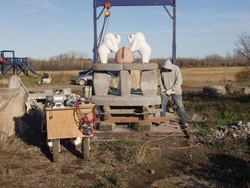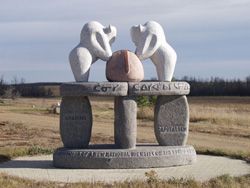DominionSections
Browse Articles
- IndependentMedia.ca
- MostlyWater.org
- Seven Oaks
- BASICS Newsletter
- Siafu
- Briarpatch Magazine
- The Leveller
- Groundwire
- Redwire Magazine
- Canadian Dimension
- CKDU News Collective
- Common Ground
- Shunpiking Magazine
- The Real News
- Our Times
- À babord !
- Blackfly Magazine
- Guerilla News Network
- The Other Side
- The Sunday Independent
- Vive le Canada
- Elements
- ACTivist Magazine
- The Tyee
- TML Daily
- New Socialist
- Relay (Socialist Project)
- Socialist Worker
- Socialist Action
- Rabble.ca
- Straight Goods
- Alternatives Journal
- This Magazine
- Dialogue Magazine
- Orato
- Rebel Youth
- NB Media Co-op
Radio
Did you hear the one about...
October 24, 2005
Did you hear the one about...
Deconstructing a Canadian Indian in the privacy of your own home

Steinhauer hammer finishing around lettering at base of "Surviving Genocide".
Hmmmm. Deconstructing Canadian Indians in the privacy of your own home? Reverse engineering intellectual property? That's a tall order for a short space. Flipping open the Master's toolbox, he grabbed the monkey wrench and tossed it into the cogs of the Machine. For a nanosecond, things lurched to a halt, and, in that short space, Steinhauer said:
"Canadian Indians, circa 2005, are a social construct created out of the remnants of Indigenous Peoples surviving genocide by subjecting them to a social engineering project spanning several centuries. As such, they can be properly thought of as the intellectual property of western civilization, Canada division."

Steinhauer wet polishing syllabic lettering on "Surviving Genocide".
With terrifying force, the Machine spit the monkey wrench across a half-vast universe, and time slouched on again. Enough day-dreaming on the job, thought Steinhauer, it's back to work. Getting out his reverse engineering tools, he sighted down that slouching time line of his ancestors, past row upon row of engineered humans. If he wasn't going to be intellectual property of the Canadian sector of western civilization, then who would he be? Tanya Wasacase had explained how identity is a function of a way of life, rather than a function of skin, hair, or eye colour, or any of the other theories of identity proposed by western civilization. Indigenous language activists, wishing to remain anonymous, had explained how language is the spiritual/ mental/ emotional/ physical story-telling voice which interactively shapes and describes that way of life. With a sudden startle reaction, Steinhauer realized that reverse engineering must begin at home; slamming shut the Master's toolbox, he got up and took the few short steps from his office to his home.
That night he had a dream. A medieval siege catapult was lobbing plague-bloated corpses onto Turtle Island, from across the big water. Countless millions of African Peoples were being dragged under that water, chained together in a seemingly endless line. The sky was dotted with mushroom-shaped clouds, while turbulent weather buffeted the surface of the earth. A full moon stood just clear of the weather, on the eastern horizon, and onto its surface a giant satellite-mounted projector was casting an alternating set of images, going from the Coca-Cola logo to Dick Cheney's face mouthing "War Is Peace" to the Pepsi logo, then back to Cheney, endlessly.
The following morning the first fall snow had melted away, but the chill of the coming winter had definitely stayed. While the Italian steam pot bubbled up espresso from the Zapatista coffee grounds, Steinhauer fired up the laptop and contemplated addictions. Deconstructing Canadian Indians has got to have something to do with addictions, doesn't it?
From liberalism he picked out individualism, and re-branded it as isolation. From the liberal concept of private property he picked out the enclosure of the commons, and re-branded it as dislocation. From the global order created by the crossing of individualism with private property he picked out labour as a commodity, and re-branded it alienation. Steinhauer was about to say "combine this unholy trinity, and you could make an addiction out of absolutely anything", but the steam pot started making those come and get it noises that all true coffee addicts can't resist.

Finished work "Surviving Genocide" on display in Steinhauer's drive-through sculpture park. A note on drive-though viewing: please do not attempt to feed or pet the sculptor.
Around the base is carved: "Genocide has 2 phases: the destruction of a national identity, and the imposition of a new national identity on the land & peoples.
The uprights have the four pillars of western civilization at the bottom, racism, patriarchy, imperialism, and capitalism, while at mid-point the four legs of some indigenous societies, humble kindness, sharing, honesty, and determination, appear.
201. In this context, let it be said that the Special Rapporteur's historical research has shown, in his view, that not all indigenous nations made the wisest of choices at all times. That is to say, at some crucial moments in their history, some indigenous nations were not capable of putting the need to unite among themselves over their individual interests, even though unity was necessary to confront properly encroachment on their sovereign attributes. This was true even when the ultimate intentions of the newcomers were already apparent. The terrible consequences inherent in allowing themselves to be divided appear not to have been totally perceived.
202. In addition, on more than one occasion they seem not to have recognized the advantages and disadvantages, in all their dimensions, nor the final consequences, of a policy of alliance with European powers. This can be said both of those who adopted this policy of alliance in line with their own on-going fratricidal struggles and of those who decided to favour one of the non-indigenous powers over the others in the military confrontations that took place in their ancestral lands.
203. Further, it is also apparent that they could not fully appreciate (or that they widely underestimated) the questionable role played, and still played, in many cases, by religious denominations or their representatives as effective instruments of the colonial enterprise in its various stages.

Finished work "Surviving Genocide"
Around the two-piece table top section, in Cree syllabics, is carved: "My grandchildren (says a spiritual being's voice speaking to a future generation yet unborn), the Great Mystery will always be here to help you. How? By you loving one another unceasingly, perserveringly, forever."
In the invisible space beneath the base lies the remains of 100s of millions of indigenous Peoples. By Raphael Lemkin's description, the survivors are in the second phase of genocide. The Master's tools, racism, patriarchy, imperialism, capitalism, are labeled on the uprights, but, rising above them is indigenous law, labeled as humble kindness, sharing, honesty, and determination. At the upper rim, the rock spirit speaks, in a pre-columbian voice, to a generation far in the future. Above, the buffalo spirits (male energy) mount the mother earth sweatlodge (female energy), and new life streams from within her.
But if le pièce de résistance, fertility, is futile, what then? Feeling at a loss, Steinhauer remembered old Pete Gregory's words, describing an experience he had one day, as he sat by the roadside watching life go by, on the Okanagan Indian Reserve # 1. A real estate salesman stopped to ask for directions. "Do you know which way to Kelowna?" Pete looked at him and said, "I don't know". "Well then, which way to Vernon?" "I don't know." Exasperated, the salesman said, "Don't you know anything, old man?" to which Pete responded, "I know I'm not lost."
Yeah. We're not lost. If we can stand our ground, keep our languages alive, keep on making babies, keep at least the memory of our way of life alive, we'll never be lost.
Part four: Panarchists to the rescue
Related articles:
By the same author:
Archived Site
The Dominion is a monthly paper published by an incipient network of independent journalists in Canada. It aims to provide accurate, critical coverage that is accountable to its readers and the subjects it tackles. Taking its name from Canada's official status as both a colony and a colonial force, the Dominion examines politics, culture and daily life with a view to understanding the exercise of power.